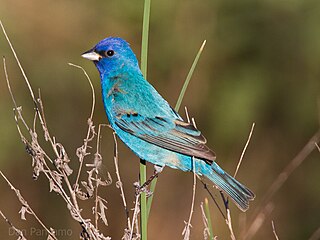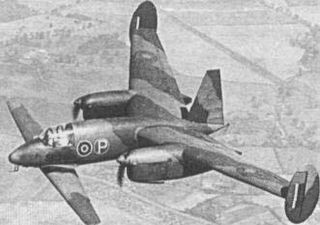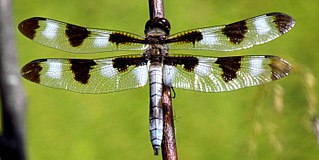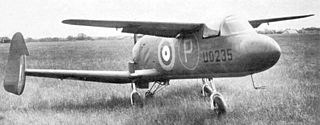
The skimmers or perchers and their relatives form the Libellulidae, the largest dragonfly family in the world. It is sometimes considered to contain the Corduliidae as the subfamily Corduliinae and the Macromiidae as the subfamily Macromiinae. Even if these are excluded, there remains a family of over 1000 species. With nearly worldwide distribution, these are almost certainly the most often seen of all dragonflies.

The indigo bunting is a small seed-eating bird in the cardinal family, Cardinalidae. It is migratory, ranging from southern Canada to northern Florida during the breeding season, and from southern Florida to northern South America during the winter. It often migrates by night, using the stars to navigate. Its habitat is farmland, brush areas, and open woodland. The indigo bunting is closely related to the lazuli bunting and interbreeds with the species where their ranges overlap.

Libellula depressa, the broad-bodied chaser or broad-bodied darter, is one of the most common dragonflies in Europe and central Asia. It is very distinctive with a very broad flattened abdomen, four wing patches and, in the male, the abdomen becomes pruinose blue.

Libellula quadrimaculata, known in Europe as the four-spotted chaser and in North America as the four-spotted skimmer, is a dragonfly of the family Libellulidae found widely throughout Europe, Asia, and North America.

The M.39B Libellula was a Second World War tandem wing experimental aircraft built by Miles Aircraft, designed to give the pilot the best view possible for landing on aircraft carriers. A scale version of the M.39 design was proposed by Miles to meet Air Ministry specification B.11/41 for a fast bomber. The M.39B was used by Miles to generate data from which the M.39 design was improved, but the M.39 project was cancelled and the M.39B broken up.

Libellula is a genus of dragonflies, commonly called skimmers, in the family Libellulidae, distributed throughout the temperate zone of the Northern Hemisphere. Most species are found in the United States, where they are the best-known large dragonflies, often seen flying over freshwater ponds in summer. Many have showy wing patterns.

The widow skimmer is one of the group of dragonflies known as king skimmers. The nymphs live in the water, molting and growing until they are ready to emerge from the water and then molting a final time to reveal their wings.

The twelve-spotted skimmer is a common North American skimmer dragonfly, found in southern Canada and in all 48 of the contiguous U.S. states.

The masked flowerpiercer is a species of bird in the tanager family, Thraupidae. It is found in humid montane forest and scrub in Venezuela, Colombia, Ecuador, Peru and Bolivia. Flowerpiercers got their name from the fact that they have a sharp hook on the tip of their upper mandible which they use to slice open the base of flowers to get at the nectar.

Libellula angelina, also known as bekko tombo, is a species of dragonfly in the family Libellulidae, native to China and Japan. It is under threat by rapid loss of the ponds and other small water bodies it uses as habitat, and is currently classified as critically endangered by the IUCN.

The Miles M.35 Libellula was a tandem wing research aircraft built by Miles Aircraft as a precursor to a proposed naval carrier fighter. It was named after the Libellula, a genus of dragonflies.

The neon skimmer is a dragonfly of the skimmer family. It can be found near ponds, lakes and slow moving streams in the southwest United States, Central America, and northern South America.
In the 10th edition of Systema Naturae, Carl Linnaeus classified the arthropods, including insects, arachnids and crustaceans, among his class "Insecta". Insects with net-veined wings were brought together under the name Neuroptera.

Cefn Blaenau is a 23-hectare Site of Special Scientific Interest in a small upland valley in Carmarthen and Dinefwr, Wales. It was designated an SSSI in 1989, primarily for its flush and spring vegetation as well as the diverse mosaic of unimproved pasture, ‘ffridd’ land, marshy grassland, wet heath, acid grassland, broadleaved woodland, streams, and small rock outcrops. These habitats, which are well represented at this site, have been greatly reduced in north Carmarthenshire due to land improvement, agricultural intensification, and afforestation. Only about 140 hectares of flush and spring vegetation remain in the county.

Nacaduba cyanea, the tailed green-banded line-blue, is a species of butterfly in the family Lycaenidae, and formerly considered a member of the genus Danis. It is found in the Indonesia, Papua New Guinea, the Solomon Islands and Australia (Queensland).

Lavells Lake is a 12.5-hectare (31-acre) Local Nature Reserve on the outskirts of Woodley, a suburb of Reading in Berkshire. It is owned by Wokingham District Council and managed by the council and The Friends of Lavell's Lake. The nature reserve is part of Dinton Pastures Country Park.

Libellula needhami, or Needham's skimmer, is a species of skimmer in the family of dragonflies known as Libellulidae. It is found in the Bahamas, Cuba, Mexico, and the United States.

















